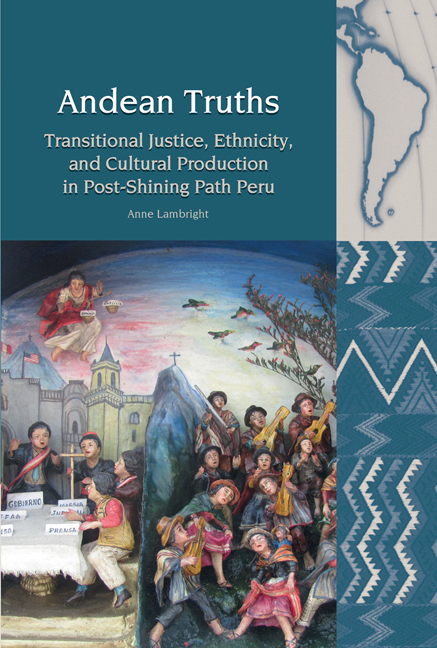Book contents
- Frontmatter
- Contents
- List of Figures
- Acknowledgements
- Introduction
- 1 Sustaining Dominant Narratives
- 2 Transitional Justice and Reconciliation through Identification
- 3 Dead Body Politics
- 4 Towards a Narrative Pachacutic
- 5 Collaborative Truth-Telling
- 6 Reconciling through other Knowledges
- 7 Conclusion
- Works Cited
- Index
5 - Collaborative Truth-Telling
- Frontmatter
- Contents
- List of Figures
- Acknowledgements
- Introduction
- 1 Sustaining Dominant Narratives
- 2 Transitional Justice and Reconciliation through Identification
- 3 Dead Body Politics
- 4 Towards a Narrative Pachacutic
- 5 Collaborative Truth-Telling
- 6 Reconciling through other Knowledges
- 7 Conclusion
- Works Cited
- Index
Summary
The Art of Edilberto Jiménez and the Chungui Testimonies
This chapter and Chapter 6 are dedicated to contemplating some of the creative cultural production that houses post-conflict Andean memories of the Shining Path era, through an analysis of written texts and visual artifacts created by inhabitants of the areas most directly and prolongedly affected by the violence. While regional artistic interpretations of the war date back to the early 1980s, here I will again concentrate on works produced in conjunction with or after the CVR's efforts. This section critically examines the work of artist-anthropologist Edilberto Jiménez and his resorting to visual forms of expression, both drawings and retablos (decorated boxes with three-dimensional scenes), to express the horrors experienced in the Ayacucho district of Chungui. The following chapter considers products of the Rescate por la memoria (Rescuing/Recovering memory) contests in diverse sectors of Ayacucho; these post-CVR interventions by Yuyarisun, a collective of Peruvian and international NGOs, invited entries in poetry, painting, illustrated stories, music, and narratives by inhabitants of the region. Both of these endeavors contribute to a decolonizing of knowledge and discourse about the Shining Path era and its aftermath, by insisting on a political-aesthetic recognition of the ecology of knowledges, the epistemological diversity, that defines Peru.
In their landmark study on popular culture in the Americas, Rowe and Schelling observe that Andean culture is predominantly an oral culture, where ‘meanings are registered and transmitted without writing.’ However, Rowe and Schelling insist:
This does not mean, as some books on orality suggest, that sound becomes the privileged vehicle for information, but rather that encoding is dispersed over a variety of actions and locations, which include ritual, theatre, music, pilgrimages, artifacts, narratives and all ways in which the earth itself is perceived as patterned with lines and significant points. These patternings add up to a multitude of ‘graphies’, of ‘writings’ available to ‘read’, and in which the native cultural ‘archive’ is stored.
The implication is that words are not the only, or even primary, means of piecing together and storing cultural and historical memory, which is embedded not just in visual symbolism, but in the Andean landscape as well.
- Type
- Chapter
- Information
- Andean TruthsTransitional Justice, Ethnicity, and Cultural Production in Post-Shining Path Peru, pp. 134 - 162Publisher: Liverpool University PressPrint publication year: 2015



